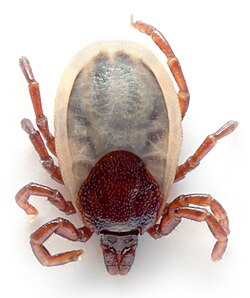U.S. National Tick Collection
- Machine translation, like DeepL or Google Translate, is a useful starting point for translations, but translators must revise errors as necessary and confirm that the translation is accurate, rather than simply copy-pasting machine-translated text into the English Wikipedia.
- Consider adding a topic to this template: there are already 1,904 articles in the main category, and specifying
|topic=will aid in categorization. - Do not translate text that appears unreliable or low-quality. If possible, verify the text with references provided in the foreign-language article.
- You must provide copyright attribution in the edit summary accompanying your translation by providing an interlanguage link to the source of your translation. A model attribution edit summary is
Content in this edit is translated from the existing German Wikipedia article at [[:de:United States National Tick Collection]]; see its history for attribution. - You may also add the template
{{Translated|de|United States National Tick Collection}}to the talk page. - For more guidance, see Wikipedia:Translation.
 Ixodes hexagonus (aka) | |
 | |
| Established | 1996 |
|---|---|
| Location | Georgia Southern University, Statesboro, Georgia |
| Type | Ticks |
| Curator | Lorenza Beati |
| Website | Tick Collection |
The U.S. National Tick Collection (USNTC) is the largest collection of ticks in the world. The vital function of the collection is to separate ticks that are medically and financially important from those that are common.
The collection is owned and curated by the Smithsonian Institution, but housed on the campus of Georgia Southern University in Statesboro, Georgia where it is under the auspices of the university's Institute of Arthropodology and Parasitology.[1] The current curator of the collection is Lorenza Beati who was appointed late in 2011 and who is also an associate professor of Biology at Georgia Southern University. Beati holds an M.D. and Ph.D.[2] The tick collection contains 850 separate species of tick.[1] Evidence suggests that the collection is "larger than all other world tick collections combined"[3] containing almost one million specimens.[4] The tick collection aids parasitic research which is of interest to health and agriculture because some species of tick carry Lyme disease and Rocky Mountain spotted fever.[1] The collection's specimens are freeze dried, bottled and coated so as to appear more vividly under a microscope.[5]
References
- ^ a b c "U.S. National Tick Collection". Georgia Southern University. Retrieved 29 January 2011.
- ^ "Lorenza Beati." Georgia Southern University Website. http://personal.georgiasouthern.edu/~lorenzab/
- ^ Durden, L. A.; Keirans, J. E.; Oliver, J. H. (October 1996), "The U.S. National Tick Collection: A Vital Resource for Systematics and Human and Animal Welfare", American Entomologist, 42 (4): 239–243, doi:10.1093/ae/42.4.239
- ^ Pavey, Rob (August 28, 2011), "World's most complete tick species collection housed at GSU", The Augusta Chronicle
- ^ Johnson, Barbara (23 April 2004). "Statesboro, GA - U.S. National Tick Collection". RoadsideAmerica.com. Retrieved 29 January 2011.
- v
- t
- e
- Military Science
- Public Health
- Eagle Field
- Georgia Southern Botanical Garden
- Hanner Fieldhouse
- Herty AMDC
- J. I. Clements Stadium
- Paulson Stadium
- U.S. National Tick Collection
- Founded: 1906
- Students: 27,173
- Endowment: $46.2 million








